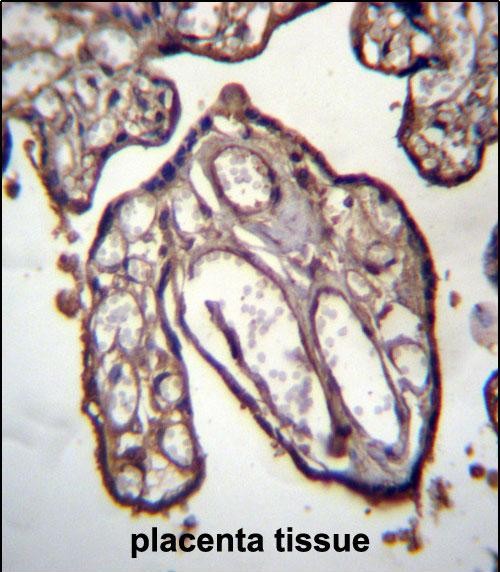ARFIP1 Antibody (Center)
Affinity Purified Rabbit Polyclonal Antibody (Pab)
- SPECIFICATION
- CITATIONS
- PROTOCOLS
- BACKGROUND

Application
| IHC-P, WB, E |
|---|---|
| Primary Accession | P53367 |
| Other Accession | Q9JHU5, NP_055262.1, NP_001020766.1, G5E8V9 |
| Reactivity | Human |
| Predicted | Mouse, Rat |
| Host | Rabbit |
| Clonality | Polyclonal |
| Isotype | Rabbit IgG |
| Calculated MW | 41738 Da |
| Antigen Region | 147-176 aa |
| Gene ID | 27236 |
|---|---|
| Other Names | Arfaptin-1, ADP-ribosylation factor-interacting protein 1, ARFIP1 |
| Target/Specificity | This ARFIP1 antibody is generated from rabbits immunized with a KLH conjugated synthetic peptide between 147-176 amino acids from the Central region of human ARFIP1. |
| Dilution | IHC-P~~1:10~50 WB~~1:1000 E~~Use at an assay dependent concentration. |
| Format | Purified polyclonal antibody supplied in PBS with 0.09% (W/V) sodium azide. This antibody is purified through a protein A column, followed by peptide affinity purification. |
| Storage | Maintain refrigerated at 2-8°C for up to 2 weeks. For long term storage store at -20°C in small aliquots to prevent freeze-thaw cycles. |
| Precautions | ARFIP1 Antibody (Center) is for research use only and not for use in diagnostic or therapeutic procedures. |
| Name | ARFIP1 {ECO:0000303|PubMed:22981988, ECO:0000312|HGNC:HGNC:21496} |
|---|---|
| Function | Plays a role in controlling biogenesis of secretory granules at the trans-Golgi network (PubMed:22981988). Mechanistically, binds ARF-GTP at the neck of a growing secretory granule precursor and forms a protective scaffold (PubMed:22981988, PubMed:9038142). Once the granule precursor has been completely loaded, active PRKD1 phosphorylates ARFIP1 and releases it from ARFs (PubMed:22981988). In turn, ARFs induce fission (PubMed:22981988). Through this mechanism, ensures proper secretory granule formation at the Golgi of pancreatic beta cells (PubMed:22981988). |
| Cellular Location | Golgi apparatus. Golgi apparatus, trans-Golgi network membrane |
| Tissue Location | Ubiquitously expressed (PubMed:9038142). Higher levels in liver, pancreas, placenta, skeletal muscle and heart (PubMed:9038142). |

Thousands of laboratories across the world have published research that depended on the performance of antibodies from Abcepta to advance their research. Check out links to articles that cite our products in major peer-reviewed journals, organized by research category.
info@abcepta.com, and receive a free "I Love Antibodies" mug.
Provided below are standard protocols that you may find useful for product applications.
Background
ARFIP1 is a putative target protein of ADP-ribosylation factor.
References
Sugiyama, N., et al. Mol. Cell Proteomics 6(6):1103-1109(2007)
Wang, A.G., et al. Biochem. Biophys. Res. Commun. 345(3):1022-1032(2006)
Foster, L.J., et al. J. Proteome Res. 5(1):64-75(2006)
Ho, W.T., et al. FEBS Lett. 537 (1-3), 91-95 (2003) :
Suzuki, Y., et al. Genome Res. 11(5):677-684(2001)
If you have used an Abcepta product and would like to share how it has performed, please click on the "Submit Review" button and provide the requested information. Our staff will examine and post your review and contact you if needed.
If you have any additional inquiries please email technical services at tech@abcepta.com.













 Foundational characteristics of cancer include proliferation, angiogenesis, migration, evasion of apoptosis, and cellular immortality. Find key markers for these cellular processes and antibodies to detect them.
Foundational characteristics of cancer include proliferation, angiogenesis, migration, evasion of apoptosis, and cellular immortality. Find key markers for these cellular processes and antibodies to detect them. The SUMOplot™ Analysis Program predicts and scores sumoylation sites in your protein. SUMOylation is a post-translational modification involved in various cellular processes, such as nuclear-cytosolic transport, transcriptional regulation, apoptosis, protein stability, response to stress, and progression through the cell cycle.
The SUMOplot™ Analysis Program predicts and scores sumoylation sites in your protein. SUMOylation is a post-translational modification involved in various cellular processes, such as nuclear-cytosolic transport, transcriptional regulation, apoptosis, protein stability, response to stress, and progression through the cell cycle. The Autophagy Receptor Motif Plotter predicts and scores autophagy receptor binding sites in your protein. Identifying proteins connected to this pathway is critical to understanding the role of autophagy in physiological as well as pathological processes such as development, differentiation, neurodegenerative diseases, stress, infection, and cancer.
The Autophagy Receptor Motif Plotter predicts and scores autophagy receptor binding sites in your protein. Identifying proteins connected to this pathway is critical to understanding the role of autophagy in physiological as well as pathological processes such as development, differentiation, neurodegenerative diseases, stress, infection, and cancer.



